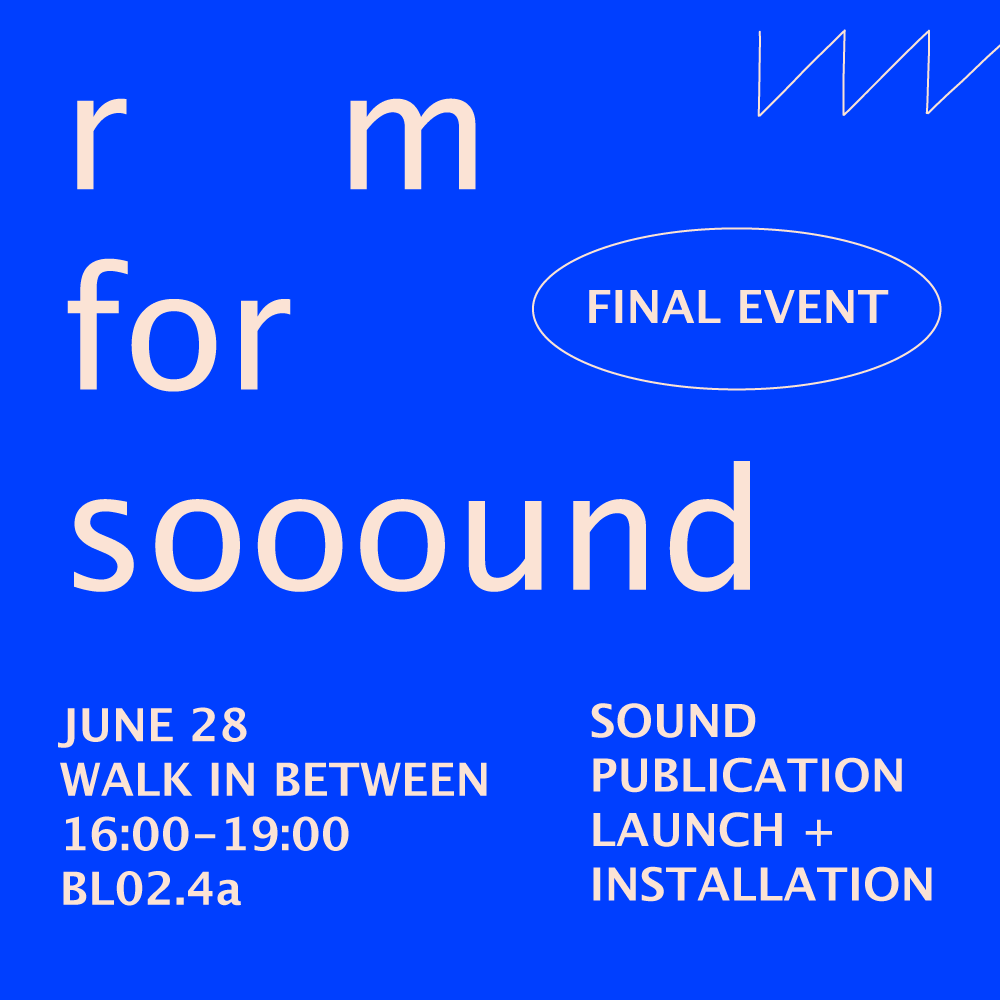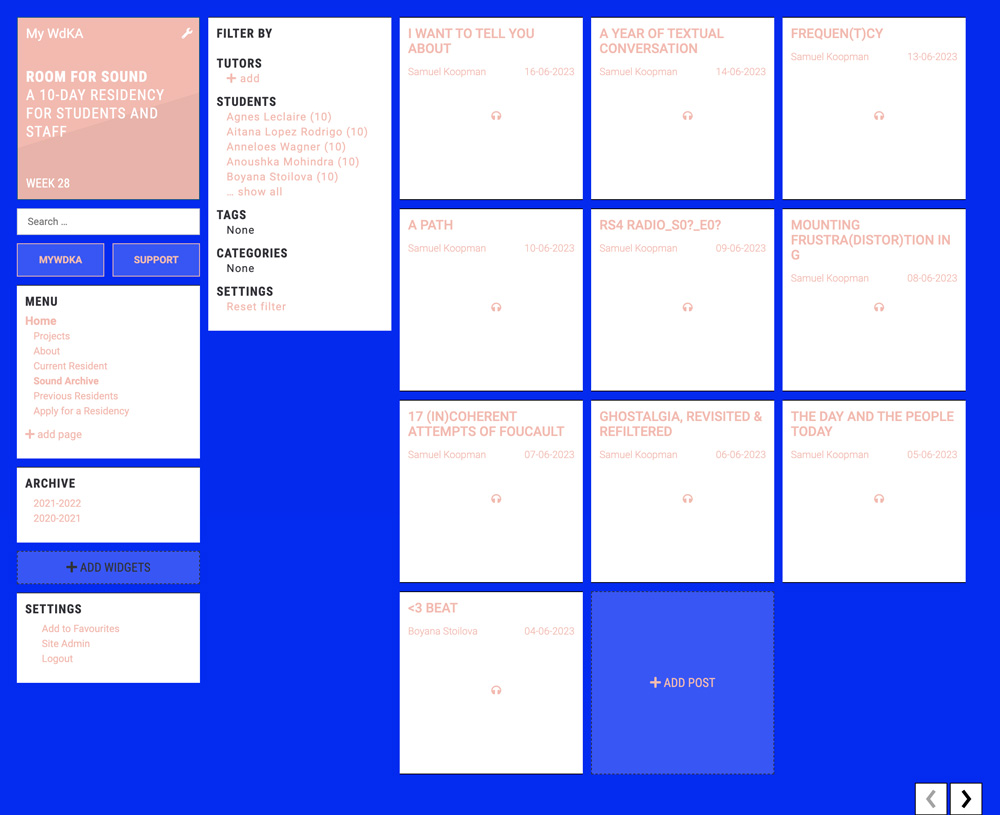Room for sound
_about
Room for Sound was a 10-day residency inside the Willem de Kooning Academy for students, teachers and other staff of the WDKA and the PZI. The room was used to either start a new artistic project or work on an existing one. In exchange for the room, the resident was asked to record a sound a day: this could range from an in-depth talk about the work to a short observational soundscape. The sounds were uploaded daily to the mywdka homepage so that the academy community could tune in to what’s happening inside the Room for Sound.
During the academic year 2022-2023, the residency welcomed 14 bachelor and master students who used the opportunity to work on their current research and elaborate on their work using the medium of sound. For some of them, it was a brand new media, for others - a moment to dive deeper into their interest in the audio format.
What was especially precious for the residents this year, was the chance to have their own place to work at the academy. The room is not a sound studio, but a working space which each one of them could decorate and transform the way they needed it. Most of them also shared that the invitation to create and publish one sound per day was a helpful push and constraint not to get lost into the endless opportunities out there.
The Room for Sound became of home of more than 120 sonic pieces and accommodated plants, illustrations, collective murals, couches, cushions, laughs and conversations. To wrap up the residency, I made an audio mix with selected snippets by the residents.
The project was initiated by Naomi Jansen, who created and coordinated the residency between 2021-2022. She invited me to become the new coordinator through an open call and interview in July 2022. I am forever thankful for this opportunity, as I really loved this project. <3
_residency outcome
▶▶ Listen to the final sound publication with selected snippets from the residencies here.
_care-taking responsibilities
The job of care-taking of the residency included several ongoing tasks:
▲ selection of residents (used python's random generator for more fair selection)
▲ welcome and introduction of the residency's rules and opportunities to the residents
▲ care of the physical room, located in the Willem de Kooning academy building
▲ care of materials and equipment for the residency (technical, materials, etc)
▲ communication (managing instagram account, graphic design of communication materials - digital and printed)
▲ archive (managing the website of the residency, on wordpress)
▲ collaboration with the management of the academy
▲ admin work (budgeting, reporting expenses, reimbursement forms etc)
▲ tuition (tutorials for residents to work with sound editing programmes, or conceptual)
_teaching at WdKA
In addition, in collaboration with Naomi Jansen, I taught at an elective class at Willem de Kooning Academy in January 2023. We organised a 2-week sound workshop "Room for Sound" and worked with bachelor students from the academy. We invited them to explore sound as another medium for their artistic and research practice, as most of the programmes are oriented to visual arts and design.
_description of the elective class
This elective was a 2-week sound workshop, organised and facilitated by Naomi Jansen and me, Alexandra Nikolova (Ål Nik). With this class, we wanted to create space for students to experiment with sound for their research and artistic practice. We planned and developed the workshop together, where Naomi worked on creating the workshops and activities of experimentation during the first week and i developed the process of collective creation of sound publication during the second week.
During the elective R m for Sooound, we collectively explored sound as a concept and a research and publishing medium. Through various group and individual exercises, we gave room to ways in which sound can be produced, experienced and transformed. The elective took place at WdKA, in which we had our own space to work in and with.
The focus did not lie on the technical aspects of sound production, but on the conceptual and poetic questions that can be asked when using sound in any art practice. For example: How could we translate an image to a sound and vice versa? How does our experience of sound differ per person? And what is the sound of ?
Next to giving room to sound, the focus of this elective was also on collectivity. In the first week this meant that through various exercises and workshops, we were continuously interpreting, repeating and transforming sounds that we produced. In the second week, the collection of sounds of week one formed the basis of working towards a collective sound publication.
The elective was based on the WDKA project Room for Sound. An artist in residency for students and staff, in which in exchange for the Room, residents have to record and upload a sound a day. This can range from an in depth talk about their work to a short observational soundscape. https://2223.mywdka.nl/roomforsound/
_method
The process of making the sound publication is taking place in the second week of the workshop. The students were invited to create concept of their collective piece (editorial setup), divide into smaller groups to create contributions (day 1 and 2) and then to split into care-takers groups to finalise the different elements of the sound publication among themselves (day 3 and 4). Finally, on day 5 the whole group experiences the final outcome.
This process is based on XPUB's 18th special issue concept - Radio Implicancies, facilitated by Femke Snelting. During the weekly releases, we reflected on reads and topics addressing various social challenges and produced sound-based publications as a group. Each week we divided in small groups - contributions teams to make the sounds and a care-taker group (of 2-3 students) to make the final release. For this sound jam, the students decided they wanted to do a sound installation at the back stairs of the WH building. In addition, the experience to be documented and an audio mix to be published afterwards.
With this sound jam, the process was visualised in a more detailed way by me. I introduced the structure in a different way: already organised for the bachelor students: the contributions making phase was clearly divided by the care-taking phase and everyone in the group took a role in both of the phases. During the contributions phase, the participants create the editorial setup as a whole group and then split in smaller teams to produce the audio files. This phase took 2 days (working time 10:00-16:00 h). Then, all of them got back into the whole group and listened to the sounds. They took notes on where the creations fit into the editorial setup and structure. Afterwards, they split again in smaller groups - named "care-taking groups". For this part, I came up with the idea to create 5 groups, so everyone on the whole team has a role here too:
▶ audio-mixing (4 students)
-get all the contribution audio files -edit them into one audio mix -export the audio mix -provide it to the Publishing, Hosting & Documentation care-takers
▶ hosting (5 students)
-create space for the whole group to listen & experience the sound publication -prepare the space: technical setup, physical space design and organisation, environment for listening/experiencing the sound -find a way to present the other care-taker groups’ work to the whole group
▶ publishing (3 students)
-get how everyone wants their name to be written -decide how to publish the audio mix -write down an introduction/description of the whole publication -create an image -publish it -bonus: they can also interview the contributors about their works, intentions etc.
▶ time-keeping (1 student)
-make sure the process goes smooth -make sure everything is happening on time and everyone is meeting the deadlines -check on how people are doing -help them organise meet-ups when needed
▶ documentation (3 students)
-document the whole process (take photos, videos, illustrations, audio recordings, interviews etc.) -organise the visuals, written materials and sounds in MS teams folders -make sure to collect the final outcomes that are published, but also work-in-progress pieces; quotes from the makers and anything else that is part of the process

